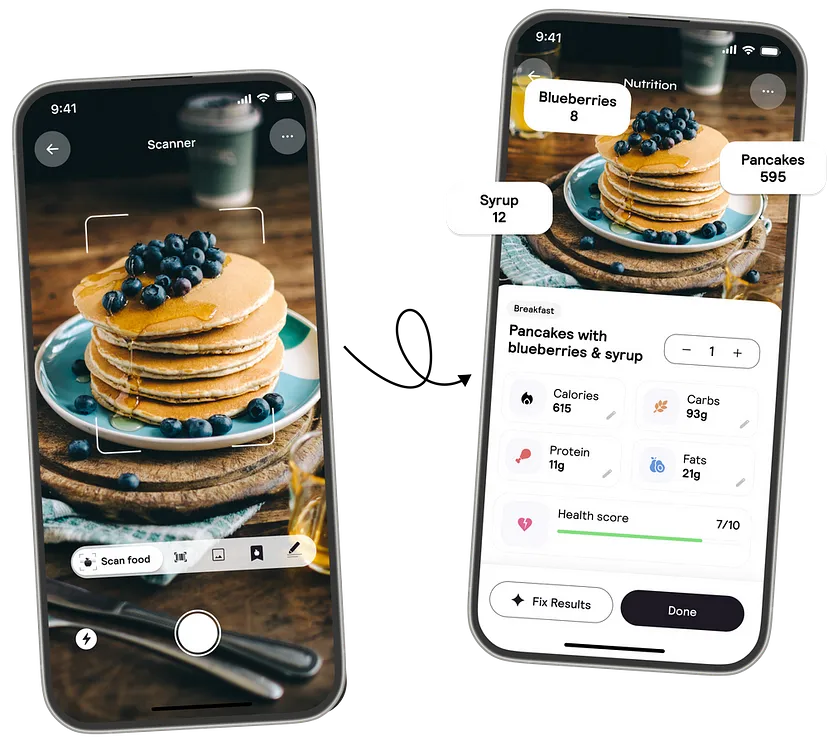What were you doing at 17?
If you’re like most people, it probably wasn’t making $1.12 million a month. I was busy figuring out how to parallel park and deciding whether buying a BlackBerry was a good idea (spoiler: it wasn’t).
Meanwhile, Zach Yadegari is quietly crushing it. He’s the mind behind Cal AI, an app that tracks calories using a simple photo. No logging. No spreadsheets. Just take a picture, and boom — calories calculated.
When I heard about this, I had to know: How does a teenager build something like this? Turns out, Zach didn’t stumble into success. He engineered it, step by step.
In a recent interview, Zach shared his process and showed us how he pulled it off. Let’s dive into what he did and how you can apply his strategies to your own projects.
1. Viral products aren’t born — they’re designed
Cal AI is designed to make people say, “Wow, that’s cool.” This is key: people love sharing things that make them look smart or introduce something new to their circle.

The app’s calorie-scanning feature is an instant conversation starter. Snap a pic, and you get immediate feedback on your food. It’s such a simple, magical moment that users naturally want to tell others.
Actionable takeaway: Build a “wow” moment into your product. Ask yourself:
-
- Does this feature make someone want to share it?
-
- How easy is it for users to show this to friends?
Zach also made sure every piece of content they created leaned into this shareability. Influencers posted videos showing off the app, and Zach’s team reposted those videos across their own accounts. This way, the app got even more exposure without needing to create all the content themselves.
Actionable takeaway: Repost user-generated content. Got someone talking about your product? Share their post. It builds credibility and saves you time.
2. Comment sections are goldmines
Most people treat comment sections like an afterthought. Not Zach. For him, comments were a key growth tool.
When influencers posted about Cal AI, Zach’s team jumped into the comments immediately. They planted questions like, “What app is this?” or “How does this work?” They also replied to almost every comment, keeping the discussion alive and boosting engagement.
This created a snowball effect. The more engagement the post had, the more the algorithm pushed it to new audiences.
Actionable takeaway:
-
- Plant curiosity: Ask questions like, “What app is this?” or “Does this work with all foods?”
-
- Respond to every comment: Even a simple “Thank you!” keeps the conversation going.
-
- Add value: When replying, include helpful details or tips about your product.
3. Building a powerhouse influencer strategy
To scale Cal AI to $1.12M per month, Zach didn’t just partner with random influencers. He built a laser-focused system for finding the right creators and negotiating deals that deliver real results. Here’s how he does it, down to the numbers.
1. Finding the right influencers
Zach understands that engagement beats reach every time. A massive follower count doesn’t matter if no one interacts with the content. Here’s his process:
-
- Curating a list: Zach fine-tunes his TikTok algorithm by interacting with health and fitness content. TikTok’s For You Page starts serving up influencers that fit his niche. His team saves these leads in a spreadsheet, noting metrics like: Average views per post. Engagement rates (calculated as likes, comments, and shares divided by views). The tone and vibe of their content.
-
- Spotting engagement pods: To avoid influencers with fake engagement, Zach checks their comments. If most commenters are influencers themselves or have the “highlighted story ring” on Instagram, that’s a red flag — it’s likely a bot-like engagement group. Instead, he looks for creators with authentic, engaged audiences who actually care about their content.
Benchmark: For TikTok, he prioritizes creators with at least 1–3% engagement rates (a healthy range for organic creators) and a consistent 50,000+ average views per post.
2. Calculating CPM and RPM
Zach uses two critical metrics to evaluate and negotiate influencer deals:
-
- CPM (Cost per Thousand Views): How much it costs to reach 1,000 people? For Zach, CPM is a way to gauge whether an influencer is offering a good deal. A competitive CPM in his niche is around $5-$10. If someone charges significantly more, they’d better have exceptional engagement.
-
- RPM (Revenue per Thousand Views): How much revenue Cal AI generates for every 1,000 views an influencer drives. Zach ensures the RPM is 2–3 times the CPM to make the deal profitable. For example:
If an influencer charges $10 CPM but generates $30 RPM, that’s a solid return.
These calculations help him lock in high-ROI deals while avoiding overpaying for creators who don’t deliver results.
3. Structuring smart deals
Zach doesn’t do one-off influencer posts. Instead, he bundles multiple videos into recurring monthly contracts. This strategy reduces costs and creates a steady stream of content.
For example:
-
- Standard deal: Four videos for $4,000 ($1,000 per video).
-
- Negotiated bundle: Four videos for $3,000 ($750 per video).
This way, Zach gets more exposure while lowering the CPM. The recurring posts also keep Cal AI in front of followers, increasing the chances of driving consistent downloads.
4. Designing viral-friendly content
Zach ensures every piece of influencer content feels organic and fits seamlessly into the creator’s feed. Here’s how he keeps it effective:
-
- Focus on storytelling, not sales: The best-performing videos don’t scream “ad.” Instead, they feature influencers casually using Cal AI in their daily lives. For example, a fitness creator might track calories for a meal in a “what I eat in a day” vlog.
-
- Seeding curiosity: The app’s name is shown in the video but rarely called out directly. This sparks curiosity in the comments, where Zach’s team often seeds questions like, “What app is this?” This subtle approach drives viewers to investigate the app themselves, often by searching for it on the App Store.
5. Measuring and optimizing results
Once the campaign is live, Zach closely tracks performance. His tools of choice? Spreadsheets and Mixpanel. Here’s what he monitors:
-
- Influencer RPM: He overlays App Store download data with influencer post dates to calculate the revenue generated per 1,000 views. If RPM drops below $20, the influencer’s deal may not be renewed.
-
- Retention and churn: Zach looks at how many downloads stick around after the initial spike. If an influencer drives high downloads but users don’t engage with the app, it’s a signal to refine the audience targeting or onboarding process.
Why this works
By combining data-driven decisions with a relentless focus on engagement, Zach stretches every dollar he spends on influencer marketing. His yardstick metrics — $5-$10 CPM and $30+ RPM — ensure every campaign is not just profitable but scalable.
If you’re building an app or product, this strategy isn’t just inspiring — it’s repeatable. Start small, focus on engagement, and let the numbers guide your decisions. You don’t need a massive budget to make this work — just a system and the persistence to refine it.
4. Pricing psychology makes a difference
Cal AI’s pricing strategy isn’t just about numbers — it’s about how the numbers are presented.
Here’s how Zach structured it:
-
- The 3-day free trial is tied to the $99/year plan. If you want to try the app, you have to sign up for the annual plan.
-
- No free trial for the $9.99/month option. This makes the yearly plan more appealing.
-
- Breaking $99 into $8.33/month makes it feel cheaper than $9.99/month, even though users pay upfront.
Zach also built transparency into the process: users get reminders on Day 2 of the trial before billing begins on Day 3. But he knows that many users forget to cancel — leading to automatic billing for the full year.
Actionable takeaway:
-
- Use free trials strategically. Offer them only for premium plans.
-
- Break annual pricing into smaller monthly equivalents to make it feel more affordable.
-
- Send reminder emails or notifications during trials to build trust — but know that many users won’t act.
5. Simplicity wins, every time
Most calorie-tracking apps are overwhelming. They have a million features — some useful, most not.
Cal AI? It does one thing: track calories. It doesn’t try to measure your hydration or track your steps. And users love it for that.

Even the onboarding process is simple. You answer a few questions (height, weight, goals), and you’re ready to go.
Zach carried this simplicity into the pricing model too. No hidden fees. No confusing options. Just a clear path: try it for free, then pay $99/year.
Actionable takeaway:
-
- Cut the clutter. Solve one problem better than anyone else.
-
- Make onboarding frictionless. The fewer steps, the better.
6. Use your failures as stepping stones
Before Cal AI, Zach launched an app called GrindClock — an alarm clock app featuring motivational speeches from people like David Goggins. It gained 20,000 downloads quickly but fizzled out.
Instead of giving up, Zach learned from it. He figured out what worked (the novelty factor) and what didn’t (lack of long-term engagement). These lessons shaped his approach to Cal AI.
Actionable takeaway:
-
- Treat failures as experiments. Ask: What did I learn? What can I improve?
-
- Pivot quickly. If something’s not working, don’t waste time trying to force it.
7. Build momentum with shareable moments
Zach leaned into every opportunity to create “wow” moments. Whether it was influencers showing off the app or users snapping photos of their meals, everything about Cal AI was designed to be shareable.
He even encouraged users to share their calorie results in comments and social media posts.
Actionable takeaway:
-
- Design for virality. Ask yourself: What’s the “wow” factor?
-
- Encourage users to share their experiences — whether it’s through features, contests, or social challenges.
8. Master the art of focus
Zach’s team isn’t juggling multiple projects. They’re laser-focused on Cal AI. This lets them move faster, update the app more often, and outpace competitors.

Actionable takeaway:
-
- Pick one project to focus on. Success often comes from doing fewer things, better.
-
- Pour your resources into scaling what’s already working instead of chasing shiny distractions.
Steal Zach’s playbook
Zach’s story isn’t about luck. It’s about strategy. Here’s how you can apply his tactics today:
-
- Build shareability into your product.
-
- Use comment sections to spark curiosity and boost engagement.
-
- Leverage influencers, but expect it to be a grind.
-
- Use pricing psychology to nudge users toward higher-value plans.
-
- Simplify everything — your product, your onboarding, your pricing.
-
- Learn from failures and pivot quickly.
-
- Focus deeply on what’s already working.
Zach Yadegari’s success isn’t magic. It’s a reminder that the small things — the planted comments, the strategic pricing, the relentless outreach — are what add up to big wins.
If he can do it at 17, what’s stopping you from trying?
Source: medium.com



